Abstract
The stereo- and regioselective total syntheses of OMe derivatives of the scarce bioactive meroterpenoids makassaric acid (1) and fascioquinol B (2) have been accomplished. The synthetic sequences are based on the following three efficient and selective catalytic reactions: Cu-catalyzed addition of Grignard compounds to an epoxide; a regioselective Barbier-type reaction, catalyzed by Cp2TiCl; and regio- and stereoselective bioinspired cyclization, also catalyzed by Cp2TiCl. These three key processes allow us to obtain the main skeletons of 1 and 2 in a few steps. The valuable synthetic proposal shown in this work provides fast access to scarce, structurally complex meroterpenes with promising biological activities, which are a sustainable source for later studies and applications in medicine.
1. Introduction
The use of organic natural compounds as a source of drugs is tremendously widespread in our society; therefore, these types of compounds are an inexhaustible source of molecules that contribute to improving the living conditions in our society [1]. In this sense, except in those cases in which it has been possible to develop artificial cultivation processes or suitable biotechnological techniques for mass production, there is a very general problem in relation to these compounds—their lack of availability in large quantities. This fact constitutes a critical limitation for the extensive study of promising compounds and their subsequent application in medicine. On the other hand, the total synthesis of natural products with complex structures and applications of interest is one of the main motivations of organic chemistry [2]. The advances in this field have allowed us to achieve synthetic goals that were unthinkable in the past, thanks, in turn, to the development of new reactions that function as useful tools for complex synthesis. Therefore, the combination of both factors is crucial in the advancement of organic chemistry, for achieving increasingly complex synthetic objectives, and, of course, for developing new products (drugs, materials, etc.). However, the preparation of drugs based on organic natural compounds, using organic synthesis, needs to be highly efficient, selective, and as short as possible to have industrial applications. These requirements force the development of new synthetic routes, which allow us to obtain the target natural compounds quickly and efficiently. In this sense, reactions promoted by titanocene(III) complexes have been revealed as a powerful tool in organic synthesis, generating new methods of CC bond formation that proceed through free radical chemistry at room temperature, under mild conditions, and are compatible with numerous functional groups [3,4,5]. Titanocene(III) complexes are capable of generating radicals on carbon atoms from various substrates, such as allyl halides and carbonates [6], α, β-unsaturated carbonyl compounds [7], ketones and their derivatives [8], and, especially, epoxides [4,5]. In this context, bioinspired radical cyclizations from epoxides, catalyzed by Cp2TiCl, are an important tool in organic synthesis. This reaction has allowed the preparation of several natural terpenoids in a few steps [4,5]. In particular, it has introduced the possibility of preparing polycyclic compounds, with a specific double bond formed in the final step of cyclization, unselectively accessible by cationic-type processes [9,10,11], which normally lead to the formation of mixtures of regioisomers. Although this synthetic strategy has been widely applied in the preparation of terpenes with an exocyclic double bond [5], the regioselective protocol for the synthesis of compounds with endocyclic unsaturations has been underused until now [12,13]. The application of this modification of Cp2TiCl-mediated bioinspired cyclizations would allow us to open short routes to access non-trivial structures.
In this context, we consider that natural bioactive meroterpenes are interesting objectives for this application, such as makassaric acid (1) and fascioquinol B (2) (see Figure 1), which both have an endocyclic double bond in the C ring. Makassaric acid (1) is a scarce meroditerpenoid (only 4.3 mg of 1 for 79 g sponge) that was first isolated from extracts of Indonesian Acanthodendrilla sp., an inaccessible sponge located at a depth of 10–15 m [14]. Interestingly, this compound showed good activity as an inhibitor of MAPKAP kinase 2 (MK2), an enzyme involved in the regulation of TNF-α [15], which is a cytokine involved in inflammatory processes. For that reason, makassaric acid (1) is claimed to be a potential drug for treating inflammatory diseases, such as rheumatoid arthritis [14]. On the other hand, fascioquinol B (2) is also a scarce metabolite isolated from the Australian deep-water (around 100 m) marine sponge Fasciospongia sp. [16]. Compound 2 also has a meroditerpenoid skeleton, and it is believed that it is a derivative from the hydrolysis of natural fascioquinol A. This compound also presented interesting biological activities, displaying promising Gram-positive selective antibacterial properties toward Staphylococcus aureus (IC50 0.95 μM and Bacillus subtilis (IC50 0.30 μM) [16].
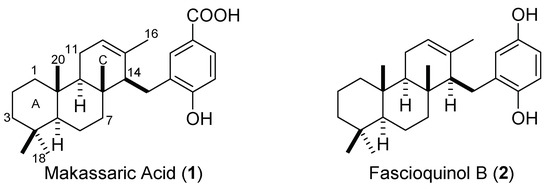
Figure 1.
Chemical structures of makassaric acid (1) and fascioquinol B (2).
In the literature, only the semi-synthesis of 1 from natural terpene sclareol is described, carried out by Basabe, Urones et al. [17]. In this semi-synthesis, the authors obtained 1 following a synthetic sequence that involved 13 steps from sclareol to an intermediate with the terpene skeleton present in 1. The manipulation of the aromatic fragment of the meroterpene increased the number of steps to 20 [17]. On the other hand, no synthesis of fascioquinol B has been described to date.
The promising biological activities described for 1 and 2, the fact that they are scarce and elusive compounds, and the challenge of developing short and efficient synthetic sequences based on titanocene(III)-catalyzed reactions, which would allow access to the terpene skeleton of these compounds, are interesting synthetic objectives. Thus, in this article, we describe the preparation of OMe derivatives of compounds 1 and 2, which include all the structural motifs that exist in the terpene skeletons and in the aromatic moieties, opening new synthetic routes applicable to such compounds.
2. Results and Discussion
2.1. Retrosynthetic Analysis
Meroterpene-type compounds are characterized by a structure with two perfectly differentiated parts. On the one hand, the terpenoid fragment, which includes various rings of different sizes (normally six-membered rings), while, on the other hand, this type of compound has an aromatic fragment. This is the reason why this type of natural product is considered to have mixed biogenesis (polyketide–terpenoid). This clear structural differentiation has allowed the development of at least two main strategies to address the synthesis of polycyclic meroterpenes. Thus, numerous syntheses based on a two-synthon strategy have been described, such as that introduced by Corey in his synthesis of K-76 [18]. This approach has been extensively used in the preparation of meroterpenes, despite the complex procedures, often with numerous steps, necessary for generating terpenic synthons. In contrast, there is a second, more direct possibility, which consists of the bioinspired cyclization of prenylated aromatic moieties, originally used by González et al. in the synthesis of dl-taondiol [19]. This strategy is shown to be more efficient and straightforward, fulfilling the requirements of selectivity and step economy necessary for developing optimal synthetic processes [20,21]. Based on these considerations, we decided to accomplish the preparation of two closely related derivatives of 1 and 2, such as compounds 3 and 4, using a bioinspired cyclization-based protocol, which would allow us to open a new pathway to access this specific group of meroterpenoids, characterized by endocyclic unsaturation at C12.
The retrosynthetic proposal for the preparation of 3 and 4 is depicted in Scheme 1.
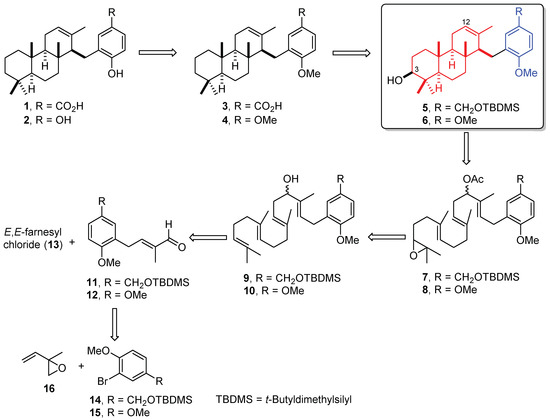
Scheme 1.
Retrosynthetic analysis for the synthesis of OMe derivatives 3 and 4.
Compounds 3 and 4, which are closely related to 1 and 2, respectively, were constructed from cyclization products 5 and 6, by removing the hydroxyl group at C3 using the Barton–McCombie protocol [22], and protective group cleavage. Compounds 5 and 6, which can be considered key products in this synthesis, were prepared from epoxypolyenes 7 and 8, respectively, using bioinspired radical cyclizations catalyzed by Cp2TiCl, which has been widely studied and developed by our research group [4,5]. This reaction allowed access to complex terpenic skeletons with complete regio- and stereoselectivity. It is important to note that only an endocyclic alkene at C12–C13 was obtained in the last step of cyclization, as we previously described [12]. On the other hand, epoxypolyenes 7 and 8 were synthesized following a sequence of four steps, from aldehydes 11–12 and commercially available E,E-farnesyl chloride(13), using a titanocene(III)-catalyzed Barbier-type reaction [6], acetylation of the hydroxyl group, epoxidation under basic media [23], and, later, acetylation. Finally, aldehydes 11–12 were obtained from aromatic bromides 14 [24] and 15, and from isoprene monoxide (16), using a highly stereoselective Cu-catalyzed addition of corresponding Grignard compounds to epoxide 16 [25], followed by oxidation of the generated allylic alcohols. The proposed retrosynthetic analysis suggests that 3 and 4 might be obtained straightforwardly, in a few steps, compared with the previously described proposals, as expected in bioinspired cyclization-based approximations, opening a short and efficient pathway for such compounds.
2.2. Synthesis of OMe Derivative of Makassaric Acid (3)
The synthesis of the OMe derivative of makassaric acid 3 was accomplished following the strategy shown in Scheme 2. This synthetic procedure presented the following two well-defined parts: (a) the synthesis of epoxypolyene 7, which included all the required structural motifs; and (b) the preparation of tricyclic meroterpene 5, a key intermediate in the proposed sequence, and its subsequent transformation into 3.
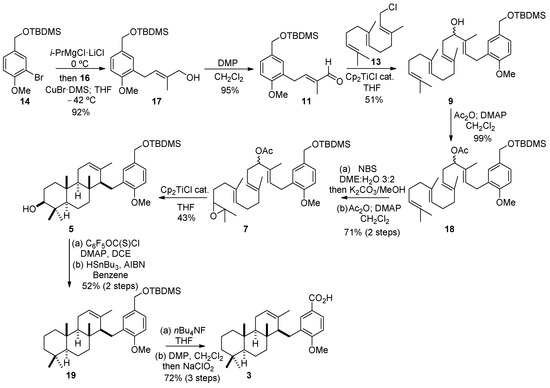
Scheme 2.
Total synthesis of meroterpene 3 using titanocene(III)-catalyzed reactions.
The synthesis of compound 7 began with the addition of the Grignard derivative of 14 (generated using Turbo Grignard [26] in THF) to commercially available isoprene monoxide (16), catalyzed by CuBr·DMS, following the described procedure [25]. This reaction allowed us to obtain E-allylic alcohol 17 with a high yield (92%) and near-complete stereoselectivity (up to 95% E isomer). The oxidation of 17 under soft conditions, using Dess–Martin periodinane (DMP) [27], yielded aldehyde 11, which was used in the preparation of the key epoxypolyene 7. Thus, the Barbier-type reaction, catalyzed by Cp2TiCl [6], of 11 with commercially available E,E-farnesyl chloride (13) yielded polyene 9 with a moderate yield (51%). This catalytic reaction was especially important in accomplishing this strategy, because it allowed the synthesis of complex polyenes with different substitution patterns, including aromatic rings. Additionally, the generated hydroxyl group was located at C12 (based on terpenes numeration, see Scheme 1), which was essential for the latter’s generation of the required endocyclic alkene [12]. Once the main skeleton of the polyene was obtained, we finished the synthesis of the key intermediate 7 using van Tamalen’s protocol [23] for regioselective epoxidation (and also deacetylation at C12), and we subsequently conducted acetylation of the hydroxyl group. Once epoxide 7 was in our hands, we submitted it to bioinspired radical cyclization, catalyzed by titanocene(III), which has been extensively studied and applied by us in natural terpene synthesis [5,12]. Under these soft reaction conditions, we successfully obtained tricyclic meroterpene 5 with a 43% yield. This cyclization occurred with complete stereo- and regioselectivity, and generated three trans-fused six-membered rings and six stereocentres in only one step. In this context, it is important to note the controlled formation of the endocyclic double bond at C12–C13 in the last step of cyclization. As we previously described, this alkene formation was due to Cp2TiCl-mediated radical fragmentation of β-acetoxy radicals (Scheme 3 and (i)) [12,28]. This fact is complementary to the formation of exocyclic alkenes that have also been obtained in several examples of bioinspired radical cyclizations, catalyzed by Cp2TiCl [4,5], and allows the synthesis of a wide group of natural terpenes with this functionalization. Additionally, this cyclization has two more important characteristics, which showed its high usefulness. First, the use of smooth reaction conditions and radical-based intermediates is completely compatible with the presence of the essential OAc group in the starting polyene, in opposition to cationic cyclizations [9,10,11], which do not allow the introduction of oxygenated functions in these compounds. Second, tertiary carbocations generated in typical cationic cyclizations are electrophilic enough to attack positions of the aromatic ring [29,30], leading to undesired byproducts. However, radical cyclizations, catalyzed by Cp2TiCl, occur without changes in the aromatic synthon, and are not in competition with the desired termination step [31,32,33] (see Scheme 3). This fact represents a significant difference, not only concerning carbocationic processes, but also in contrast with radical cyclizations promoted by other transition metals or PET processes [34].
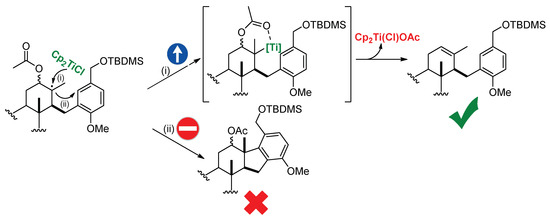
Scheme 3.
Possible termination steps in the cyclization of 7, catalyzed by titanocene(III).
With all this information in mind, we can conclude that bioinspired radical cyclization, catalyzed by Cp2TiCl, shows, again, its great potential in the field of natural terpene synthesis, offering solutions to unresolved problems in other kinds of cyclization processes and allowing us straightforward access to complex terpenic skeletons.
Once the cyclization compound 5 was obtained, the synthesis carried on removing the hydroxyl group at C3 through the Barton–McCombie protocol to yield 19 [22], –OTBDMS cleavage using nBu4NF, and the further oxidation of the generated primary alcohol with DMP and Pinnick conditions [35]. Thus, we obtained the OMe derivative of makassaric acid 3 in only 12 steps and with a 5% global yield. A comparison with the previously described semi-synthesis of 1 indicated that our route decreased the synthetic sequence in eight steps, until an analog intermediate was obtained. This result confirmed that our initial aim, designing and executing a more efficient and straightforward synthesis of meroterpenes, has been reached in the case of compound 3.
2.3. Synthesis of OMe Derivative of Fascioquinol B (4)
As we described in Section 2.2, the application of three key, highly stereo- and regioselective catalytic procedures has allowed us to open efficient access to meroterpenoid-type compounds, with 3 being a good example. However, the application of this proposed route to the synthesis of other examples of meroterpenoids, to confirm the generality of the process, would be desirable. Thus, here, we also propose the preparation of other examples of meroterpenes, such as compound 4, a close derivative of fascioquinol B (2). The synthesis of 4 is depicted in Scheme 4.
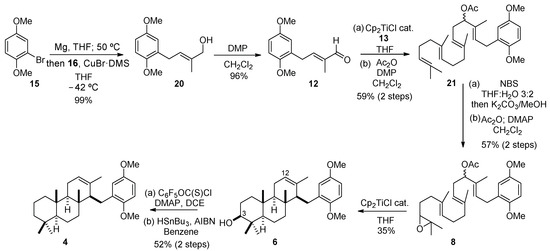
Scheme 4.
Total synthesis of meroterpene 4.
The synthesis started with the previously mentioned prenylation of aromatic 15, via the addition of the corresponding Grignard derivative to isoprene monoxide 16 [25]. Thus, the corresponding allylic alcohol 20 was obtained with a nearly quantitative yield and excellent stereoselectivity (up to 95% E isomer). Oxidation with DMP [27] generated aldehyde 12, which was used in the construction of the required hydroxylated polyene. For this, compound 12 was submitted to a Barbier-type reaction, catalyzed by Cp2TiCl [6], to yield alcohol 10 (see Scheme 1) with a good yield (60%). Subsequently, the protection of the hydroxyl group at C12, as acetate, generated the desired polyene 21. Once compound 21 was in our hands, we accomplished the synthesis of the required epoxide for later cyclization, following the classical regioselective procedure described by van Tamelen [23], and with further protection of the hydroxyl group as acetate, to yield compound 8 with a 57% yield after two steps. Bioinspired radical cyclization, catalyzed by titanocene(III) [12], generated the corresponding tricyclic compound 6 in a completely regio- and stereoselective reaction. The yield of this reaction (35%) can be considered acceptable, considering the number of CC bonds and stereocentres formed in only one step. All the considerations indicated for the cyclization of 7 to yield 5 (Scheme 2 and Scheme 3), as the selective formation of endocyclic unsaturation, can also be applied to this reaction. Finally, the synthesis of compound 4 was completed using the two-step Barton–McCombie protocol [22], which removed the hydroxyl group located at C3 (52% yield and two steps). Thus, we could obtain meroterpene 4, closely related to 2, in only nine steps and with a 5.8% global yield. The synthesis of 2 would be completed using the previously described oxidation-reduction sequence [36].
3. Experimental Section
3.1. General Details
Deoxygenated solvents and reagents were used for all reactions involving Cp2TiCl. THF and benzene were freshly distilled from Na. Other dry solvents, such as CH2Cl2 and 1, 2-dichloroethane (DCE), were acquired from commercial supplier (Sigma-Aldrich, Steinheim, Germany) (Cp2TiCl2 was acquired from a commercial supplier (Alfa Aesar, A11456, Thermo Fisher Scientific, Kandel, Germany). Products were purified by flash chromatography on VWR silica gel (40–60 μm). Yields refer to analytically pure samples. NMR spectra were recorded in NMR Varian Direct Drive (400 MHz or 500 MHz, Agilent Technologies, Santa Clara, CA, USA) spectrometers. The following known compounds were isolated as pure samples and showed NMR spectra that matched those of the reported compounds: 12 [37], 14 [24], and 20 [38].
3.2. Main General Procedures
3.2.1. General Procedure for Cu-Catalyzed Grignard Compound Additions (GP-1)
The corresponding Grignard derivative (1.2 mmol, previously prepared by treatment of the aryl bromide 14–15 (1 mmol) with Mg (1.4 mmol) in dry THF (3 mL) at 50 °C, or with iPrMgCl·LiCl (1.3 mmol) in dry THF (3 mL) at 0 °C) was added over 3 h via a syringe pump to a −42 °C solution of 16 (1 mmol), and CuBr·DMS (0.5 mmol) in dry THF (15 mL). The mixture was stirred for an additional 16 h at room temperature. Then, Et2O (20 mL) was added and the mixture was washed with a saturated solution of NH4Cl, dried (anhyd. Na2SO4), and the solvent was removed. Products 17 and 20 were isolated by flash chromatography of the residue (mixtures of hexane/EtOAc) and characterized using spectroscopic techniques. See Supplementary Materials for more details.
3.2.2. General Procedure for Barbier-Type Prenylation of Aldehydes Catalyzed by Cp2TiCl (GP-2)
Strictly deoxygenated THF (20 mL) was added to a mixture of Cp2TiCl2 (0.2 mmol) and Mn dust (8 mmol) under an Ar atmosphere, and the suspension was stirred at room temperature until it turned lime green (after about 15 min). Then, 2,4,6-collidine (6 mmol) and Me3SiCl (4 mmol) were added. Subsequently, a solution of carbonyl compounds 11 or 12 (1 mmol) and farnesyl chloride (13) (2 mmol) in THF (2 mL) was slowly added over a period of 2.5 h, and the solution was stirred for 6 h. The reaction was then quenched with a saturated solution of NaHCO3 and extracted with EtOAc. The organic layer was washed with brine, dried (anhyd. Na2SO4), and the solvent was removed. Products were purified by flash chromatography on silica gel (mixtures of hexane/EtOAc) and characterized using spectroscopic techniques. See Supplementary Materials for more details. In some experiments, trimethylsilyl derivatives were observed. In these cases, the residue was dissolved in THF (20 mL) and stirred with nBu4NF (10 mmol) for 2 h. The mixture was then diluted with EtOAc, washed with brine, dried (anhyd. Na2SO4), and the solvent was removed.
3.2.3. General Procedure for Bioinspired Cp2TiCl-Catalyzed Cyclization Reactions (GP-3)
Strictly deoxygenated THF (20 mL) was added to a mixture of Cp2TiCl2 (0.2 mmol) and Mn dust (8 mmol) under an Ar atmosphere, and the suspension was stirred at room temperature until it turned lime green (after about 15 min). Then, a solution of epoxypolyene 7 or 8 (1 mmol), 2,4,6-collidine (6 mmol) in THF (2 mL), and Me3SiCl (4 mmol) was added, and the mixture was stirred for 16 h. The reaction was then quenched with 2 N HCl and extracted with EtOAc. The organic layer was washed with brine, dried (anhyd. Na2SO4), and the solvent was removed. Products 5 and 6 were isolated by flash chromatography of the residue (mixtures of hexane/EtOAc) and characterized using spectroscopic techniques. See Scheme 1 for details.
4. Conclusions
We have developed a short and efficient synthetic sequence for the synthesis of biologically active natural meroterpenoids with trisubstituted endocyclic unsaturation. Our strategy relies on three key metal-catalyzed reactions, such as the Cu-catalyzed addition of Grignard derivatives to isoprene monoxide, the Ti-catalyzed Barbier-type reactions of α, β-unsaturated aldehydes with complex farnesyl chloride, and the bioinspired Cp2TiCl-catalyzed cyclizations of functionalized epoxypolyenes. The combination of these catalytic procedures, which proceed under mild reaction conditions and with high regio- and stereoselectivity, allowed us access to the meroterpenoid skeletons in short synthetic sequences. The synthetic approximation could be considered an efficient and short route for the preparation of this specific class of meroterpenoids, in comparison with other existing protocols, offering an inexhaustible source of these compounds for their further application in biological and pharmacological studies.
Supplementary Materials
The following are available online at https://www.mdpi.com/article/10.3390/molecules27082400/s1: Experimental details of the synthesis of all new substrates. Copy of 1H NMR and 13C NMR spectra of all new compounds.
Author Contributions
Conceptualization, J.J. and G.C.; investigation, J.R. and J.J.; writing—original draft preparation, J.J., J.R. and G.C.; writing—review and editing, J.J. and G.C.; supervision, J.J.; funding acquisition, J.J. All authors have read and agreed to the published version of the manuscript.
Funding
This research was funded by FEDER (EDRF)/Junta de Andalucía-Consejería de Transformación Económica, Industria, Conocimiento y Universidades (P18-FR-2877), grant number A-FQM-079-UGR18.
Institutional Review Board Statement
Not applicable.
Informed Consent Statement
Not applicable.
Data Availability Statement
Data is contained within the article or Supplementary Materials.
Conflicts of Interest
The authors declare no conflict of interest.
Sample Availability
Samples of the compounds 3, 4, 5, 6, 7, 8, 9, 19, and 20 are available from the authors.
References
- Brahmachari, G. Chemistry and Pharmacology of Naturally Occurring Bioactive Compounds. In Chemistry and Pharmacology of Naturally Occurring Bioactive Compounds; Brahmachari, G., Ed.; CRC Press: Boca Ratón, FL, USA, 2013; pp. 1–8. [Google Scholar]
- Corey, E.J. The Logic of Chemical Synthesis: Multistep Synthesis of Complex Carbogenic Molecules (Nobel Lecture). Angew. Chem. Int. Ed. 1991, 30, 455–612. [Google Scholar] [CrossRef]
- Rosales Martínez, A.; Pozo Morales, L.; Díaz Ojeda, E.; Castro Rodríguez, M.; Rodríguez-García, I. The proven versatility of Cp2TiCl. J. Org. Chem. 2021, 86, 1311–1329. [Google Scholar] [CrossRef] [PubMed]
- Justicia, J.; Álvarez de Cienfuegos, L.; Campaña, A.G.; Miguel, D.; Jakoby, V.; Gansäuer, A.; Cuerva, J.M. Bioinspired terpene synthesis: A radical approach. Chem. Soc. Rev. 2011, 40, 3525–3537. [Google Scholar] [CrossRef] [PubMed]
- Morcillo, S.P.; Miguel, D.; Campaña, A.G.; Álvarez de Cienfuegos, L.; Justicia, J.; Cuerva, J.M. Recent applications of Cp2TiCl in natural product synthesis. Org. Chem. Front. 2014, 1, 15–33. [Google Scholar] [CrossRef] [Green Version]
- Estévez, R.E.; Justicia, J.; Bazdi, B.; Fuentes, N.; Paradas, M.; Choquesillo-Lazarte, D.; García-Ruiz, J.M.; Robles, R.; Gansäuer, A.; Cuerva, J.M.; et al. Ti-catalyzed Barbier-type allylations and related reactions. Chem. Eur. J. 2009, 15, 2774–2791. [Google Scholar] [CrossRef]
- Paradas, M.; Campaña, A.G.; Estévez, R.E.; Álvarez de Cienfuegos, L.; Jiménez, T.; Robles, R.; Cuerva, J.M.; Oltra, J.E. Unexpected TiIII/Mn-promoted pinacol coupling of ketones. J. Org. Chem. 2009, 74, 3616–3619. [Google Scholar] [CrossRef]
- Frey, G.; Luu, H.-T.; Bichovski, P.; Feurer, M.; Streuff, J. Convenient titanium(III)-catalyzed synthesis of cyclic aminoketones and pyrrolidinones-development of a formal [4+1] cycloaddition. Angew. Chem. Int. Ed. 2013, 52, 7131–7134. [Google Scholar] [CrossRef]
- Yoder, R.A.; Johnston, J.N. A case study in biomimetic total synthesis: polyolefin carbocyclizations to terpenes and steroids. Chem. Rev. 2005, 105, 4730–4756. [Google Scholar] [CrossRef] [Green Version]
- Brunoldi, E.; Luparia, M.; Porta, A.; Zanoni, G.; Vidari, G. Biomimetic cyclizations of functionalized isoprenoid polyenes: A cornucopia of synthetic opportunities. Curr. Org. Chem. 2006, 10, 2259–2282. [Google Scholar] [CrossRef]
- Ungarean, C.N.; Southgate, E.H.; Sarlah, D. Enantioselective polyene cyclizations. Org. Biomol. Chem. 2016, 14, 5454–5467. [Google Scholar] [CrossRef]
- Jiménez, T.; Morcillo, S.P.; Martín-Lasanta, A.; Collado-Sanz, D.; Cárdenas, D.J.; Gansäuer, A.; Justicia, J.; Cuerva, J.M. Combining the power of TiIII-mediated processes for easy access to hydroxylated polycyclic terpenoids: Synthesis of sesterstatin 1 and C–D rings of aspergilloxide. Chem. Eur. J. 2012, 18, 12825–12833. [Google Scholar] [CrossRef] [PubMed]
- González-Delgado, J.A.; Arteaga, J.F.; Herrador, M.M.; Barrero, A.F. First total synthesis of (+)-apotrisporin E and (+)-apotrientriols A–B: A cyclization approach to apocarotenoids. Org. Biomol. Chem. 2013, 11, 5404–5408. [Google Scholar] [CrossRef] [PubMed]
- Williams, D.E.; Telliez, J.-B.; Liu, J.; Tahir, A.; van Soest, R.; Andersen, R.J. Meroterpenoid MAPKAP (MK2) inhibitors isolated from the Indonesian marine sponge Acanthodendrilla sp. J. Nat. Prod. 2004, 67, 2127–2129. [Google Scholar] [CrossRef] [PubMed]
- Kotlyarov, A.; Neininger, A.; Schubert, C.; Eckert, R.; Birchmeier, C.; Volk, H.-D.; Gaestel, M. MAPKAP kinase 2 is essential for LPS-induced TNF-alpha biosynthesis. Nat. Cell. Biol. 1999, 1, 94–97. [Google Scholar] [CrossRef] [PubMed]
- Zhang, H.; Khalil, Z.G.; Capon, R.J. Fascioquinols A-F: Bioactive meroterpenes from a deep-water southern Australian marine sponge, Fasciospongia sp. Tetrahedron 2011, 67, 2591–2595. [Google Scholar] [CrossRef]
- Basabe, P.; Martín, M.; Bodero, O.; Blanco, A.; Marcos, I.S.; Urones, J.G. Synthesis of (+)-makassaric acid, a protein kinase MK2 inhibitor. Tetrahedron 2010, 66, 6008–6012. [Google Scholar] [CrossRef]
- Corey, E.J.; Das, J. Total synthesis of the complement inhibitor K-76 in racemic form. Structural assignment to “K-76 monocarboxylic acid”. J. Am. Chem. Soc. 1982, 104, 5551–5553. [Google Scholar] [CrossRef]
- González, A.G.; Martín, J.D.; Rodríguez, M.L. Stereospecific total synthesis of dl-taondiol methyl ether. Tetrahedron Lett. 1973, 14, 3657–3664. [Google Scholar] [CrossRef]
- Trost, B.M. The atom economy-a search for synthetic efficiency. Science 1991, 254, 1471–1477. [Google Scholar] [CrossRef]
- Newhouse, T.; Baran, P.S.; Hoffmann, R.W. The economies of synthesis. Chem. Soc. Rev. 2009, 38, 3010–3021. [Google Scholar] [CrossRef]
- Barton, D.H.R.; McCombie, S.W. A new method for the deoxygenation of secondary alcohols. J. Chem. Soc. Perkin Trans. 1975, 16, 1574–1585. [Google Scholar] [CrossRef]
- van Tamelen, E.E.; Storni, A.; Hessler, E.J.; Schwartz, M. The biogenetically patterned in vitro oxidation-cyclization of farnesyl acetate. J. Am. Chem. Soc. 1963, 85, 3295–3297. [Google Scholar] [CrossRef]
- Xiao, Z.; Cai, S.; Shi, Y.; Yang, B.; Gao, S. A photo-induced C–O bond formation methodology to construct tetrahydroxanthones. Chem. Commun. 2014, 50, 5254–5257. [Google Scholar] [CrossRef] [PubMed]
- Jung, M.E.; D’Amico, D.C. Stereospecific rearrangement of optically active tertiary allylic epoxides to give optically active quaternary aldehydes: Synthesis of α-alkyl amino aldehydes and acids. J. Am. Chem. Soc. 1995, 117, 7379–7388. [Google Scholar] [CrossRef]
- Ziegler, D.S.; Wei, B.; Knochel, P. Improving the halogen-magnesium exchange by using new Turbo-Grignard reagents. Chem. Eur. J. 2019, 25, 2695–2703. [Google Scholar] [CrossRef]
- Dess, D.B.; Martin, J.C. A useful 12-I-5 triacetoxyperiodinane (the Dess-Martin periodinane) for the selective oxidation of primary or secondary alcohols and a variety of related 12-I-5 species. J. Am. Chem. Soc. 1991, 113, 7277–7287. [Google Scholar] [CrossRef]
- Justicia, J.; Oller-López, J.L.; Campaña, A.G.; Oltra, J.E.; Cuerva, J.M.; Buñuel, E.; Cárdenas, D.J. 7-endo radical cyclizations catalyzed by titanocene(III). Straightforward synthesis of terpenoids with seven-membered carbocycles. J. Am. Chem. Soc. 2005, 127, 14911–14921. [Google Scholar]
- Ishiara, K.; Ishibashi, H.; Yamamoto, H. Enantioselective biomimetic cyclization of homo(polyprenyl)arenes. A new entry to (+)-podpcarpa-8,11,13-triene diterpenoids and (−)-tetracyclic polyprenoid of sedimentary origin. J. Am. Chem. Soc. 2001, 123, 1505–1506. [Google Scholar] [CrossRef]
- Rosales, V.; Zambrano, J.L.; Demuth, M. Regioselective palladium-catalyzed alkylation of allylic halides with benzylic Grignard reagents. Two-step synthesis of abietane terpenes and tetracyclic polyprenoid compounds. J. Org. Chem. 2002, 67, 1167–1170. [Google Scholar] [CrossRef]
- Justicia, J.; Oltra, J.E.; Cuerva, J.M. General approach to polycyclic meroterpenoids based on Stille couplings and titanocene catalysis. J. Org. Chem. 2004, 69, 5803–5806. [Google Scholar] [CrossRef]
- Castillo, A.; Quílez del Moral, J.F.; Barrero, A.F. Studies in cyclization of aromatic epoxy-acyclicpolyprenes: Lewis superacids and titanocene chloride. Nat. Prod. Commun. 2017, 12, 657–658. [Google Scholar] [CrossRef] [PubMed] [Green Version]
- Mühlhaus, F.; Weissbarth, H.; Dahmen, T.; Schnakenburg, G.; Gansäuer, A. Merging regiodivergent catalysis with atom-economical radical arylation. Angew. Chem. Int. Ed. 2019, 58, 14208–14212. [Google Scholar] [CrossRef] [PubMed] [Green Version]
- Rosales, V.; Zambrano, J.; Demuth, M. Straightforward synthesis of aromatic polycyclic terpenoids through biomimetic cascade cyclizations triggered by photochemical electron transfer. Eur. J. Org. Chem. 2004, 2004, 1798–1802. [Google Scholar] [CrossRef]
- Bal, B.S.; Childers, W.E.; Pinnick, H.W. Oxidation of α,β-unsaturated aldehydes. Tetrahedron 1981, 37, 2091–2096. [Google Scholar] [CrossRef]
- Gansäuer, A.; Justicia, J.; Rosales, A.; Worgull, D.; Rinker, B.; Cuerva, J.M.; Oltra, J.E. Transition-metal-catalyzed allylic substitution and titanocene-catalyzed epoxypolyene cyclization as a powerful tool for the preparation of terpenoids. Eur. J. Org. Chem. 2006, 2006, 4115–4127. [Google Scholar] [CrossRef]
- Manners, G.D.; Wong, R.Y. Acid-catalysed intramolecular cyclization of geranyl hydroquinone derivatives from Cordia alliodora. X-ray crystal and molecular structure of 1,2,3,3a,4,9,10,10a-octahydro-5,8-dimethoxy-3,10-dimethyl-3a,9-epoxybenz[f]azulene. J. Chem. Soc. Perkin Trans. 1981, 1, 1849–1854. [Google Scholar] [CrossRef]
- Masaki, Y.; Hashimoto, K.; Sakuma, K.; Kaji, K. Synthetic studies on isoprenoidquinones. I. A facile regio- and stereocontrolled synthesis of protected hydroquinones with an omega-hydroxyprenyl or hydroxygeranyl side chain. Chem. Pharm. Bull. 1984, 32, 3952–3958. [Google Scholar] [CrossRef] [Green Version]
Publisher’s Note: MDPI stays neutral with regard to jurisdictional claims in published maps and institutional affiliations. |
© 2022 by the authors. Licensee MDPI, Basel, Switzerland. This article is an open access article distributed under the terms and conditions of the Creative Commons Attribution (CC BY) license (https://creativecommons.org/licenses/by/4.0/).